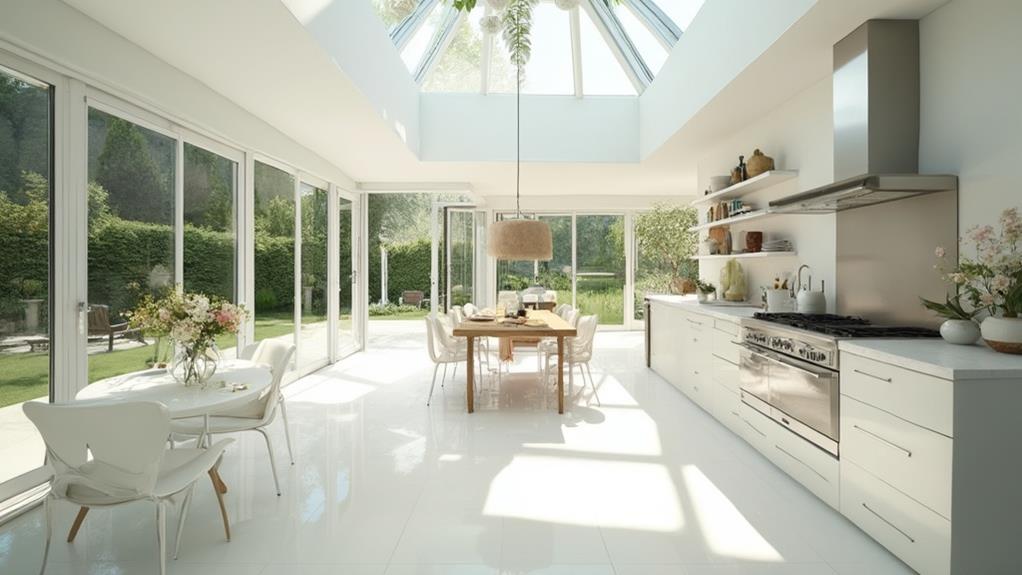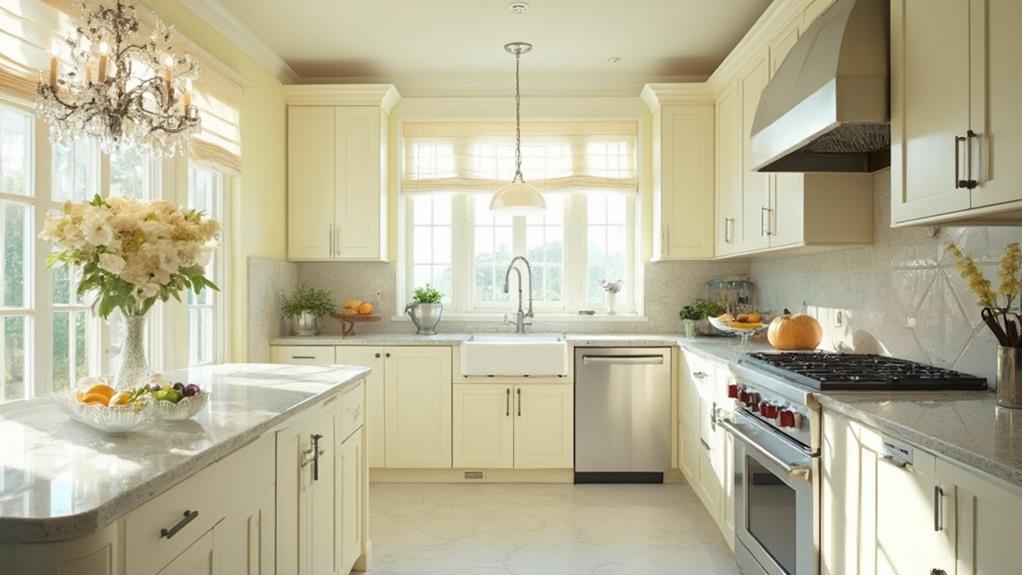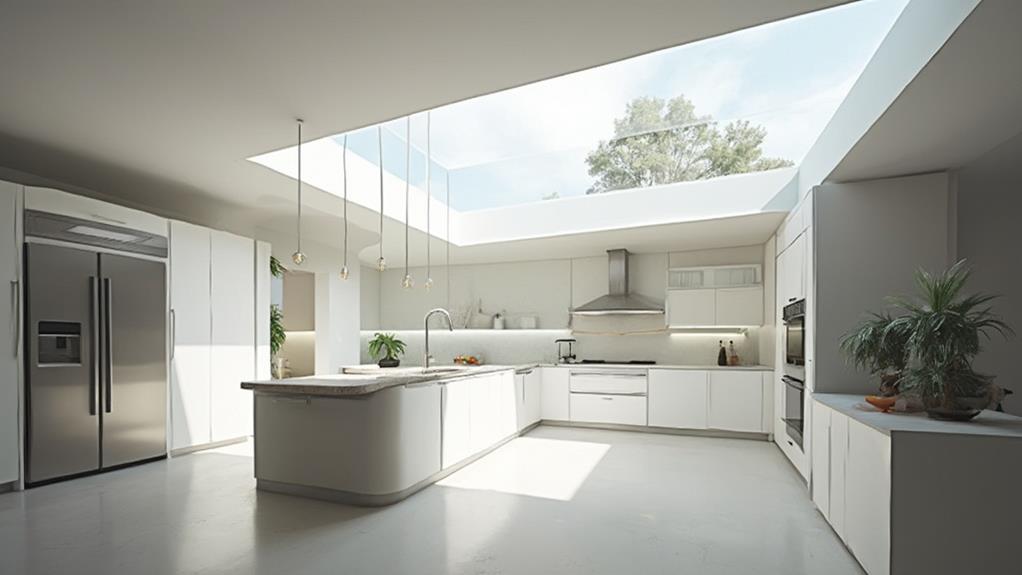To maximize natural light in your kitchen design, start by strategically placing windows based on your kitchen's orientation. Use reflective surfaces like glossy finishes, polished countertops, and stainless steel appliances to bounce light around the room. Opt for light, bright color schemes that reflect rather than absorb sunlight. Incorporate glass elements, such as cabinet doors or backsplashes, to enhance light transmission. Consider installing skylights or light tubes to bring in sunlight from above. Finally, embrace an open floor plan to allow light to flow freely throughout the space. These techniques will help you create a brighter, more inviting kitchen that feels spacious and energizing.
Strategic Window Placement

How can you maximize natural light in your kitchen through window placement? Start by assessing your kitchen's orientation and identifying the best locations for windows. South-facing windows will provide consistent light throughout the day, while east-facing windows offer bright morning light. West-facing windows bring in warm afternoon sun, and north-facing windows provide soft, diffused light.
Consider installing larger windows or multiple smaller ones to increase the amount of natural light. Place windows above countertops or sinks to illuminate work areas effectively. If possible, incorporate a skylight or clerestory windows to bring light from above. Don't forget about corner windows, which can dramatically increase light and provide panoramic views.
Be strategic with window treatments. Opt for sheer curtains or blinds that can be easily adjusted to control light and privacy. If you're renovating, consider removing upper cabinets on exterior walls to make room for additional windows. For kitchens with limited exterior wall space, think about adding a glass door or sidelights to bring in more natural light. Remember, well-placed windows not only brighten your kitchen but also create a more spacious and inviting atmosphere.
Reflective Surfaces and Materials
While strategic window placement is key, you can further amplify natural light in your kitchen through the use of reflective surfaces and materials. Start by incorporating glossy finishes on cabinets, countertops, and backsplashes. High-gloss paint or lacquer on cabinetry will bounce light around the room, creating a brighter atmosphere. For countertops, consider polished materials like quartz, marble, or stainless steel. These surfaces not only reflect light but also add a touch of elegance to your kitchen.
Glass elements can significantly enhance light reflection. Install glass-front cabinets or open shelving with mirrored backings to create depth and increase brightness. Don't forget about your appliances; stainless steel finishes can act as light-reflecting surfaces. For flooring, opt for materials with a slight sheen, such as polished hardwood or glossy tiles. Lastly, strategically place mirrors in your kitchen to maximize light reflection. A large mirror on a wall opposite a window can dramatically increase the amount of natural light in the space, making your kitchen feel more open and inviting.
Light-Enhancing Color Schemes

Choosing the right color scheme can dramatically enhance natural light in your kitchen. Opt for light, bright colors that reflect rather than absorb sunlight. White is the ultimate light-enhancing color, creating a clean, airy feel while maximizing brightness. Consider using various shades of white for walls, cabinets, and countertops to add depth without sacrificing luminosity.
Soft, pale hues like light gray, beige, or pastel yellow can also amplify natural light while adding warmth to your space. These colors work well for walls or larger surfaces. For a pop of color, incorporate light blues or greens, which evoke a sense of nature and freshness without diminishing light reflection.
When selecting finishes, choose those with a slight sheen or gloss. They'll bounce light around the room more effectively than matte surfaces. Don't forget about your ceiling – painting it a lighter shade than your walls can make the room feel taller and brighter.
Lastly, consider using two-tone color schemes. Pair lighter upper cabinets with slightly darker lower cabinets to create visual interest while maintaining an overall bright atmosphere in your kitchen.
Glass and Translucent Elements
Transparency is key when it comes to maximizing natural light in your kitchen. Glass and translucent elements play a crucial role in achieving this goal. Consider replacing solid cabinet doors with frosted or clear glass panels to allow light to penetrate through storage spaces. This not only brightens the kitchen but also creates an illusion of spaciousness.
Incorporate a glass backsplash to reflect light and add depth to your kitchen. Choose from various options like clear, textured, or mirrored glass to suit your style.
For larger kitchens, consider installing a glass partition instead of a solid wall to separate spaces while maintaining an open, airy feel.
Don't overlook the power of skylights or light tubes to bring natural light from above. These can be especially effective in interior kitchens with limited exterior wall space. For a modern touch, opt for glass countertops or islands that allow light to pass through.
Lastly, consider replacing solid exterior doors with glass-paneled versions to let in more sunlight. French doors or sliding glass doors can dramatically increase natural light while offering a seamless connection to outdoor spaces.
Skylights and Light Tubes

Skylights and light tubes offer unparalleled opportunities to flood your kitchen with natural light from above. These overhead solutions can transform dark, gloomy spaces into bright, inviting areas that inspire culinary creativity and enhance your mood.
Skylights are windows installed directly into your roof, allowing sunlight to pour in throughout the day. They come in various sizes and styles, from fixed panels to vented options that can be opened for air circulation. You'll need to consider your roof's structure and local building codes when installing skylights, but the results can be dramatic.
Light tubes, also known as sun tunnels or solar tubes, are a more compact alternative. They consist of a small dome on your roof that captures sunlight and channels it through a reflective tube into your kitchen. These are ideal for spaces where traditional skylights aren't feasible due to attic space or structural constraints.
Both options can significantly reduce your reliance on artificial lighting during daylight hours, potentially lowering your energy bills. They also provide a connection to the outdoors, allowing you to track the passage of time and changing weather conditions while you work in your kitchen.
Open Floor Plans
Open floor plans have revolutionized kitchen design, breaking down barriers between cooking spaces and living areas. By removing walls that once separated kitchens from dining rooms and living spaces, you're not only creating a more spacious feel but also allowing natural light to flow freely throughout your home.
When you opt for an open floor plan, you'll notice how sunlight from windows in adjacent rooms can penetrate deeper into your kitchen space. This increased light exposure can make your kitchen feel brighter, more inviting, and visually larger. It's an excellent way to maximize the natural light you already have without adding new windows or skylights.
To further enhance the light-spreading effect of your open floor plan, consider using reflective surfaces like glossy countertops, stainless steel appliances, or mirror backsplashes. These elements will bounce light around the space, amplifying its brightness. Additionally, choose light-colored finishes for your walls, cabinets, and flooring to create a sense of airiness and openness. By combining these design elements with an open floor plan, you'll create a kitchen that's not only more functional but also bathed in natural light throughout the day.
Conclusion
As you step into your newly designed kitchen, sunlight dances across gleaming countertops and sparkles through glass cabinets. You'll feel energized and uplifted in this bright, airy space. Remember, maximizing natural light isn't just about aesthetics—it's about creating a vibrant, welcoming heart for your home. With these strategies, you've transformed your kitchen into a sun-drenched oasis where memories are made and joy flows as freely as the sunbeams streaming through your windows.

